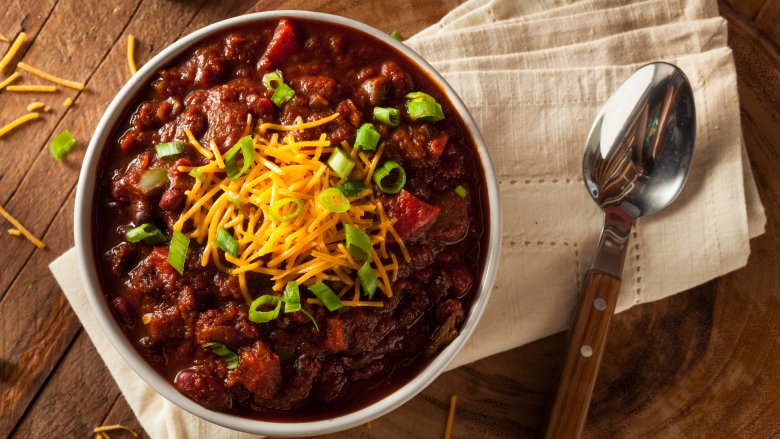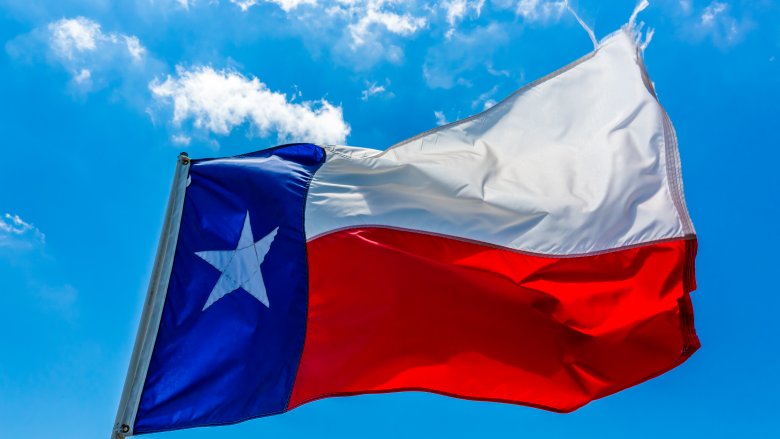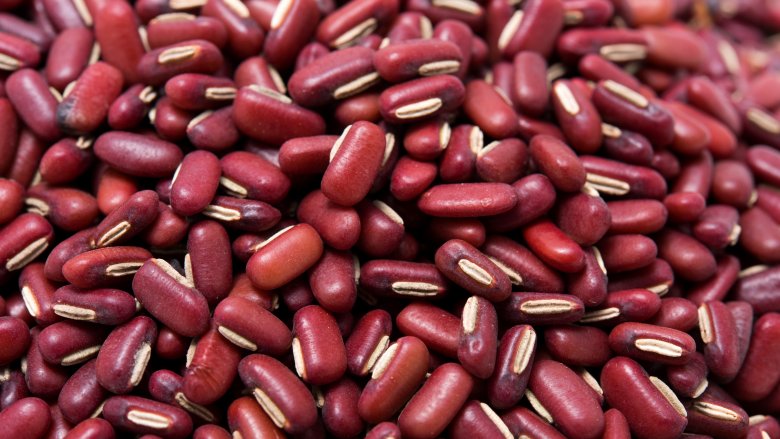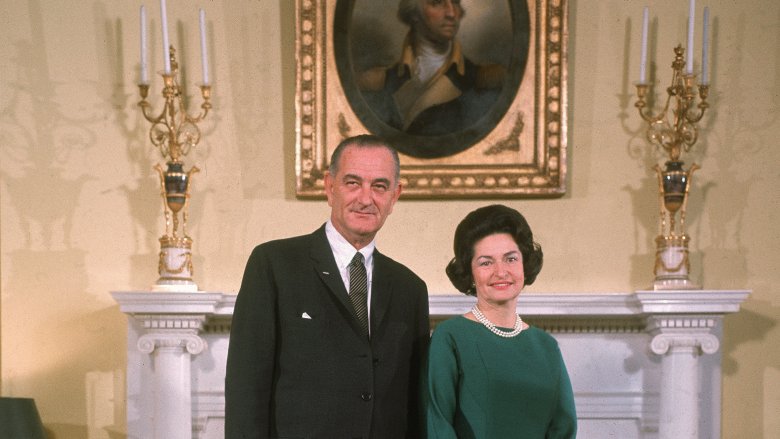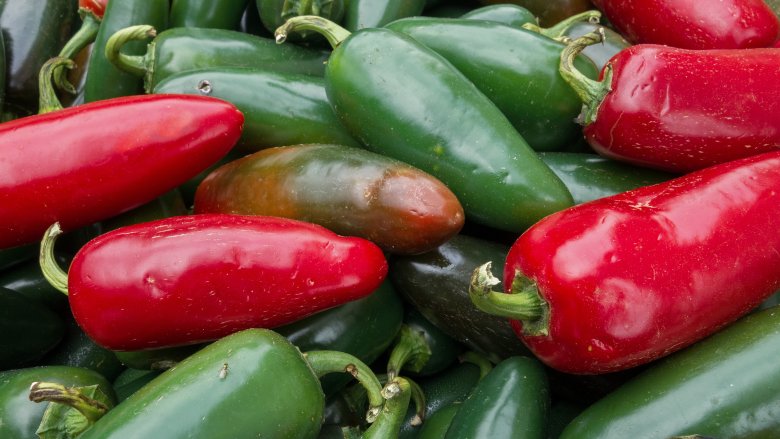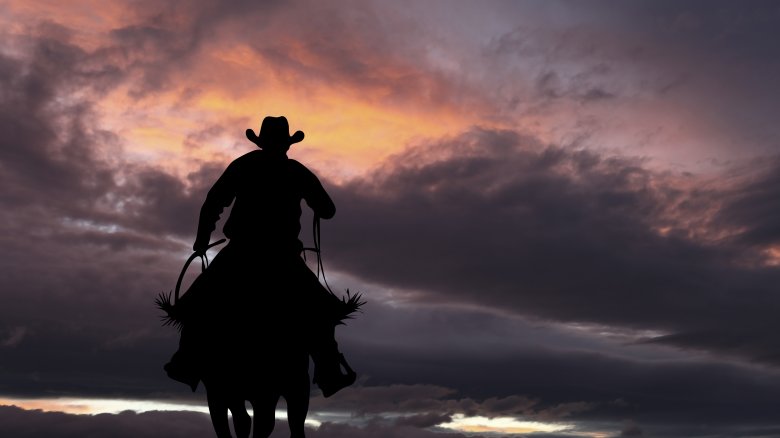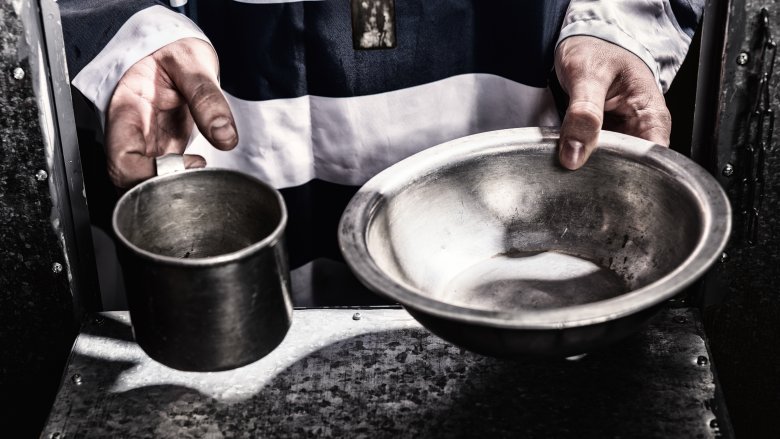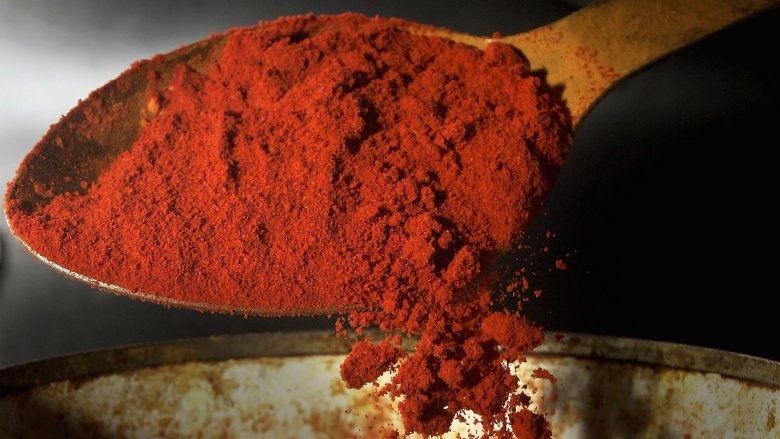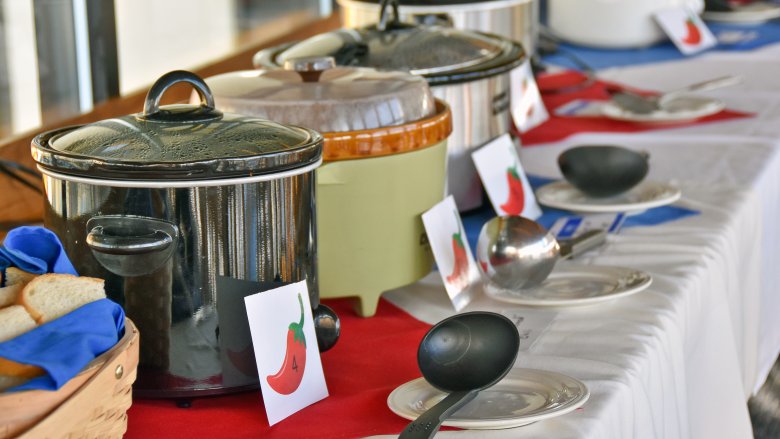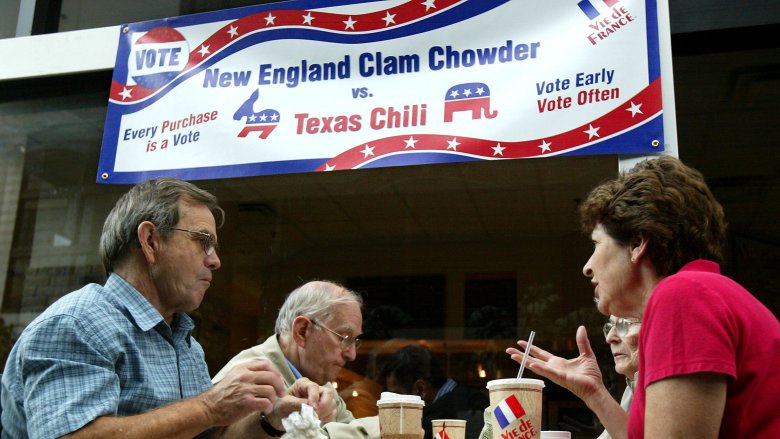The Untold Truth Of Chili
Meat, chili powder, chopped onion, spices, and maybe some beans. Chili is an iconic American staple, served everywhere from upscale Tex-Mex restaurants to hot dog carts on the sidewalk. It's hearty, it's flavorful, and everyone seems to have their own unique recipe that celebrates this seemingly humble dish. But chili has a surprising history, peppered with mysterious characters, salt-of-the-earth consumers, and some passionate connoisseurs. So where exactly did this dish come from? Did it originate from an enigmatic nun or in nineteenth century Texas prisons? What exactly is the Mexican connection? And why are people so die-hard about what chili should and shouldn't be? Here's the untold truth of chili.
It's the official state dish of Texas
The Lone Star Republic has some amazing food, from tacos to barbecue to Cajun specialties. With such a diverse cadre of cuisines, how do you pick what's the best, most iconic dish? Well, Texans unanimously agree: the dish that represents them the most in culture and history is chili. It became official all the way back in 1977, when the 65th Legislature passed a resolution stating, "in recognition of the fact that the only real 'bowl of red' is that prepared by Texans, hereby proclaims chili as the "'State Dish of Texas.'" The proclamation also defines what it is to be a Texan, stating that one "cannot be a true son or daughter of this state without having his [or her] taste buds tingle at the thought of the treat that is real, honest-to-goodness, unadulterated Texas chili." If ever there was proof of regional pride in a dish, this is it.
Beans are optional
Many chili recipes incorporate a variety of beans, such as pinto, kidney, and chili beans. And I certainly grew up with big, fat kidney beans in my chili as my father's recipe called for them. So I was surprised to learn that beans are actually optional in chili, and not a staple ingredient. In Texas, for example, beans are not only excluded from chili, but are the subject of scorn from Texan chili aficionados — once they're added to the dish, it ceases to be chili and instead becomes goulash or frijoles borrachos.
Texan pride aside, it makes sense that beans are optional when you consider the name of the dish: chili. So as long as you have some form of meat flavored by spicy chilis, it's safe to say you're eating chili. It's when you start adding beans, or any other seemingly rogue ingredient like tofu or pasta, that the definition of what you're cooking is called into question.
Ladybird Johnson's recipe is famous
November of 1963 was a hectic time in our nation's history. In the midst of the upheaval, Lyndon B. Johnson, then the vice president, took the Presidential Oath after John F. Kennedy was assassinated.
In those years, first ladies were known for sharing their favorite recipes. Among Ladybird Johnson's favorite recipes was her Pedernales River Chili, which was named after the Johnson's Texas Hill Country ranch. It included beef, onions, cumin, hot sauce, and oregano, along with garlic and tomatoes, and was apparently so popular that Mrs. Johnson had cards made to mail to folks all around the country. Note that Mrs. Johnson did not include beans in her state chili recipe — she was from Texas, after all.
It's not from Mexico
So where exactly did chili originate? Consider the chili stands of Texas in the 1800s. The dish they sold was unique to Texas, and not Mexican in origin as some might believe. Rather, chili has its roots in the Canary Islands, which were under Spanish control in the 1700s, when the government of New Spain recruited people to migrate to what's now San Antonio, Texas. The women who settled there prepared dishes of stew made with meat, garlic, onions, cumin, and chili peppers — flavors similar to the Berber flavor profiles of Morocco. So chili is 100 percent American in origin, created by immigrants who got the job done.
A mysterious nun might have invented it
Some foods are so iconic they have more than one origin story, maybe with a little bit of truth in all of them. One of the more esoteric origin stories of chili is that of la dama de azul, or the lady in blue, a mysterious nun who appeared to the indigenous population of Texas and New Mexico in the 1600s. Allegedly, the lady in blue was a woman by the name of Mary of Agreda, a Spanish nun. According to legend, she had the power of bilocation — the ability to appear in two locations at once. So although she lived in Spain and never physically left the country, she mysteriously appeared to the people of the Southwest and taught them about God, as well as encouraged baptism.
So what does this pious woman have to do with chili? As the myth goes, when she was tending to the poor and hungry during one of her hypnotic, ecstatic trances, she taught them about a fiery stew containing meat (venison or antelope), tomatoes, onions, and chili peppers.
The soup of the devil
Not everyone was happy to indulge in the spicy, hearty stew that popped up in Texas and New Mexico in the early 1600s. And given the religious climate of the time — The Spanish Inquisition was in full swing — it's not surprising that Spanish priests over the next few centuries did not look fondly upon chili. Rather, they preached against eating it, as they considered it an indulgence people should not take part in, dubbing it "the soup of the devil" because of its spicy flavor and aphrodisiac qualities.
But that didn't stop the pungent stew from proliferating, partly because of the suppression, partly because of the flavor, and party because of the convenience. In spite of the priest's admonishments, chili only became more popular as the years went by.
It was the cowboy dish of choice
If you've ever been camping for long stretches without the comforts of running water and a kitchen, you no doubt appreciate that first hot meal you get once you're back in civilization. And while camping today can be pretty rugged, the American cowboys who spent most of their days on the trail were far more hardcore. It's only fitting, then, that they would need food that is portable and easily prepared on cattle runs and gold expeditions.
What better food than chili to keep hungry adventurers fed while out on the road? Trail cooks pounded dried beef, fat, pepper, salt, and chili peppers together into a brick, hence they called it brick chili. These bricks were easy to transport, and could be reconstituted with boiling water over a campfire. Convenient, nutritious, and flavorful — what more do you need?
It was a prison favorite
There's one more group of people who claim to have created chili on their own: Texas prisoners during the later half of the 1800s. And while it seems odd to think of chili as a classic prison food, it makes sense when you consider Texas in a regional context. What would be cheap to come by at that time and place? Likely beef, though prisoners wouldn't get the good stuff — they'd get the tough scraps that had to be chopped into small pieces. Chilis and spices were also cheap and plentifu. And being Texas, that's all you need.
Chili became so prevalent at prisons that inmates used to rank prisons according to the quality of their recipe. Apparently some institutions made such delicious chili that former inmates would say what they missed most from their time in lockup was a good bowl of this Texan staple.
Chili powder was a game changer
Lots of recipes, from tacos to Sloppy Joes, call for chili powder, an ingredient that's easy to get at your local supermarket. And if you shop at the right places, you can get all kinds of chili powder: serrano, poblano, chipotle, you name it. But back in the day, access to ingredients was much more restricted. And in the case of chilies, you were likely reliant on whatever grew in your region.
That all changed in the late 1890s, when a Texan by the name of Willie Gebhardt invented chili powder. Because he couldn't get the chilies he wanted year-round, he bought a huge amount, then pulverized them in a meat grinder so he would have it whenever he needed it. And starting in 1894, he began selling the powder to other people, who appreciated the convenience of having it done for them. Thanks to Gebhardt, we all have it on our spice rack today.
Chili cook-offs are serious business
If you watch Chopped or any other competitive cooking show, you're participating in a classic American tradition: Cooking contests. The first ever cooking contest was the Pillsbury Bake-off, which took place in New York City back in 1949. Chili cook-offs were not long behind, first documented at the Texas State Fair in Dallas in 1952, and becoming more common a decade later. By the end of the 1960s, chili was everywhere, thanks to LBJ being in the White House, and events like the 1967 Terlingua chili cook-off.
Today, chili cook-offs are serious business. Dedicated chefs and chili aficionados can register with the International Chili Society, which charges a fee of $350 per cook-off and sanctions over 200 chili cook-offs per year. Big winners from state and regional contests can then go on to compete in the World's Championship Chili Cook-off. But if you use beans in your red or green chili, you need not apply.
It's personal and political
Beans or no beans. The addition of pasta. Beef or turkey? And how about tofu? Depending on your chili indoctrination, these ingredients might or might not be acceptable additions to your family recipe. And while it's totally acceptable for chili purists to dismiss the addition of cinnamon, coffee, or other ingredients, one thing is clear: Chili is a dish that's intimately personal and often political. Many families guard their secret chili powder recipes, for example, and others are more than happy to slather their chili with cheddar cheese and sour cream. I personally swear by a ground turkey chili recipe that uses chipotle peppers and corn, but everyone has their own signature recipe for this American classic. As long as you enjoy the dish you make for your family, that's enough in and of itself.
